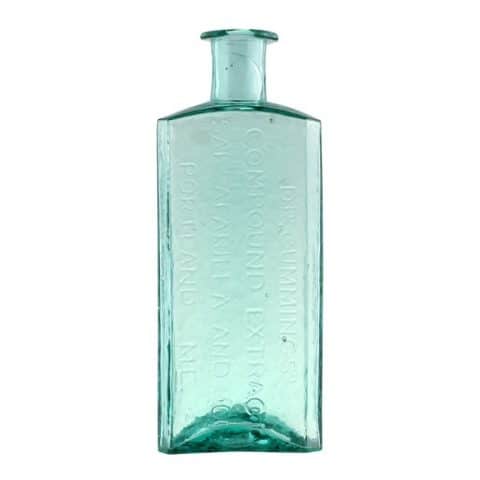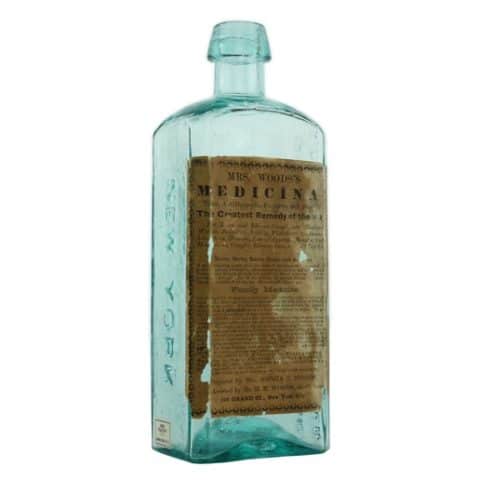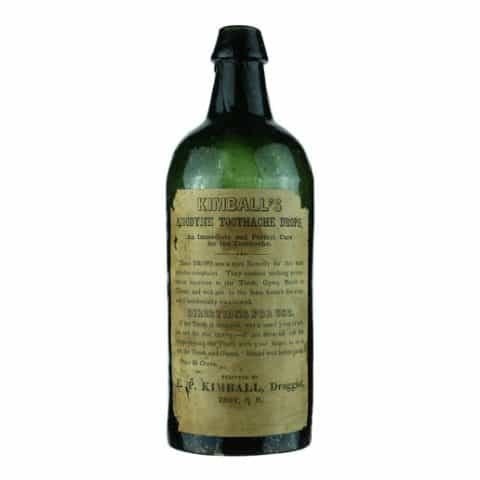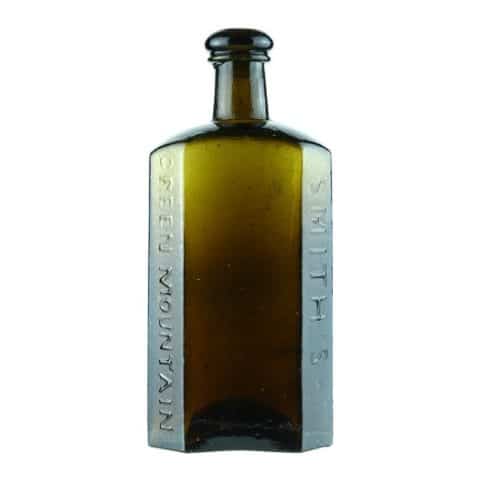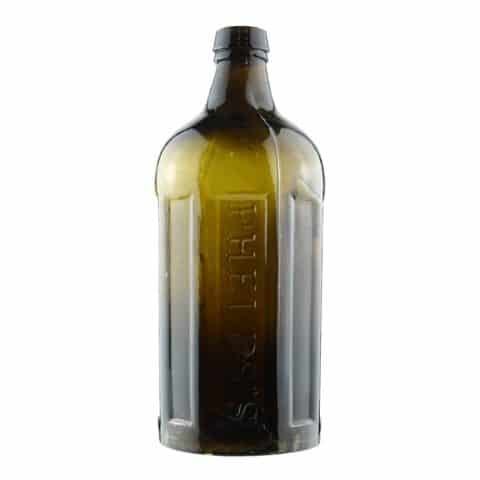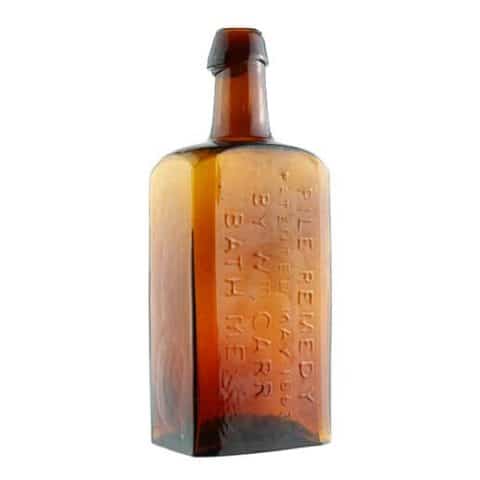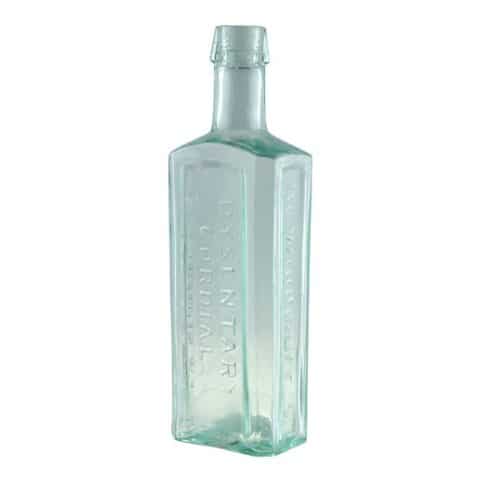Ladies Star (Embossed Star) Self Helper Co. Pacific
Ladies Star
(Embossed Star)
Self Helper Co.
Pacific
Dr. Moscu I. Herdan
Clear Rectangular Medicine
Provenance: Eric McGuire Collection
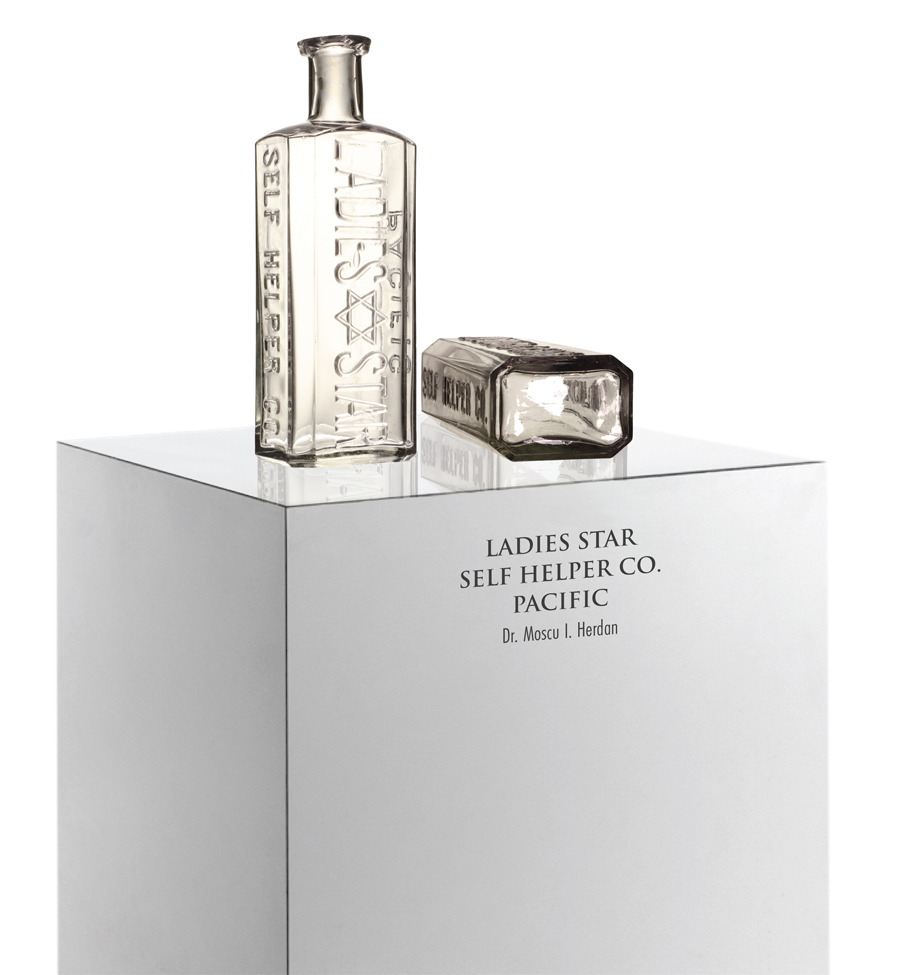
Born in Bucharest, Romania, about 1864, Moscu I. Herdan came to the United States sometime between 1884 and 1890. His early years are a little sketchy. The 1890 voting register for Chicago, Illinois, notes he had lived in Chicago for one year but lived in Illinois for four years. It states his naturalization occurred in Kansas City in 1884. He claimed he had medical degrees from several schools, none verified. Dr. Herdan dreamed about making it big in the medical world and tried several ideas. None seemed to have worked. The bottle he had produced is tangible evidence of unfortunate circumstances that kept Dr. Herdan from achieving success.
Dr. Herdan’s first advertisement occurred in Atchison, Kansas, setting the stage for his future advertising style, where he generally worked from the hotel he used as a residence. He often stated that he was in residence permanently, which was usually not very long. Herdan also openly said that he preferred women and children patients.

By December 1890, Herdan had moved west from Atchison to Salt Lake City and set up shop in the St. James Hotel, advertising “Diseases of Women a Specialty.”
Suicide is generally considered an act of desperation to avoid continued mental or physical pain. On January 10, 1891, in his room at the St. James Hotel, Herdan attempted to kill himself. He left Salt Lake the following Tuesday, knowing his act would have ruined his reputation as a trusted physician. At the depot, before the train pulled out, he amused the bystanders with a speech in which he paid his compliments to the city and its people and said that he would never revisit the place.

He may have gone back to Chicago for a short while, as he had a brother located there, as well as a woman that he wanted for his wife. By the end of January, Herdan had located his residence and business in Reno, Nevada, living at and working from the Inverness Hotel. In March 1891, Herdan added Carson City to his consultation circuit, working out of the Arlington Hotel, in Carson, on Mondays.
Dr. Herdan began working the cities of Reno, Carson and Virginia City, with his primary residency dictated by demand, and this changed a number of times. This circuit, with which Herdan maintained he was not a traveling physician, divided his time into what must have been a very difficult schedule. He advertised almost daily in the local newspapers, which would have been a significant part of his budget. Occasionally, Herdan would ply new ground in the vicinity, as noted by a one-day visit to the Union Hotel in Verdi, Nevada.
The first mention of Herdan’s connection with his patent medicine venture was in Reno, when the newspaper noted, “Dr. Herdan has applied for a patent on a medicine invented by himself called Self Helper for private diseases, which he claims is the greatest medicine yet produced. He has refused $2,500 for it, but will form a company and place it on sale in every drug store in the United States.” It is unclear if he actively began production for his “Ladies Star” then, but he probably did not. Newspaper advertisements did not occur for another six months.
By December 1891, he claimed a new “permanent” residence in Winnemucca, Nevada. Aside from seeing patients from his room at the Winnemucca Hotel, Herdan had an additional idea for this city. The following January, he proclaimed his intention to open a sanitarium for drunkenness based on the new gold-chloride treatment recently practiced by Dr. Keeley of Dwight, Illinois. It was appropriately named The Nevada Sanitarium for the Cure of Drunkenness. Little is known of the establishment, which was located in the Silver State Hall. It was a novel idea, and most Nevada towns had no shortage of individuals who imbibed too much alcohol. Whether the residents wanted to quit alcohol use is another issue. The sanitarium was a failure, and owing back rent, Herdan left town on May 9, 1892, and headed south for Austin, Nevada.

On November 19, 1892, The Self Helper Company was organized in Austin under the corporate laws of Nevada. Along with Herdan were two other directors, David S. Truman and Osmer B. Vincent. Truman was a practicing lawyer and continued in that capacity. He likely obtained the corporate papers for the new Pacific Self-Helper Co. Truman worked as a lawyer for the remainder of his career, mainly in Nevada, until his mysterious disappearance in 1910. He was never heard from or located after that date.
The primary objective of this new corporation was the “purchase of Dr. M. Herdan and his co-owners, a certain patent for the right to manufacture exclusively those medicines made by them and for which a patent has been applied for from the Hon. Commissioner of Patents of the United States of America, by said Dr. M. Herdan, and which said medicines are known as and called Dr. Herdan’s SELF HELPER and Dr. Herdan’s LADIES STAR and also any trade marks he may obtain therefore.” The corporation’s capital stock was $500,000, with $342,500 being paid up at the company’s inception. The paid-up amount appears quite large and is difficult to believe. This amount was probably inflated or may not represent actual cash.
The partners soon decided to move their laboratory and bottling facilities to San Francisco, where supplies were more readably available. Herdan remained in Austin, where he continued his practice as a physician. Osmer B. Vincent became the agent in San Francisco. He was a telegrapher by trade and was probably a great asset to this new company in relaying information about the Pacific Self Helper Co. to various newspapers. Truman’s role was perhaps just as an investor, along with dealing with legal issues as they may arise.
Meanwhile, Herdan became frustrated with his inability to operate as a physician in Austin successfully. He openly expressed his feelings in the local newspaper by stating, “The inhabitants are very sociable but don’t get sick often enough, which healthful condition he attributes to the lack of bad whisky and gossip.”

Our well-made museum example is six inches in height and was produced using clear glass. It could be the product of any established glass works of the period. Embossed on three of four sides, the front panel reads ‘LADIES (Star of David) STAR’ in large condensed sans serif characters running from shoulder to base. The right side panel reads ‘PACIFIC’ while the left side panel reads ‘SELF HELPER CO.’ The reverse large bottle face is devoid of lettering, probably reserved for a label. The base is smooth. Advertisements for Ladies Star occurred in newspapers throughout the West during 1892 and 1893.

Herdan left Austin in January 1893, but the day before leaving, he sold a block of his shares in the Self Helper Company, and that night he lost $220 at Faro. (The Silver State, Winnemucca, Nevada, January 31, 1893. Gambling was one of his weaknesses.
Herdan finally convinced his love interest, Mollie Abraham, to marry him. They tied the knot in Chicago on February 20, 1893. After returning to Austin, their relationship became strained and Mollie decided to leave him, and she returned to Chicago. Herdan stayed in Austin. The Reveille posted, “Dr. Herdan has returned to Austin. He had partially raised money enough to take him back to Chicago but blew it in a game of stud poker Saturday night, and from present indications, he will spend the summer in Austin. His sleek plug (slang for top hat) sits at the same angle, however, say 45 degrees, as formerly, and his shirt front is as immaculate as ever. He still persists in trying to run a lot of business in Austin, including this office, but we take pleasure in announcing that he is “not in it.” This clearly indicates that Herdan worked newspapers to the best of his ability.
Herdan left Austin, Nevada, on April 19, 1893, and it was thought he was going to Lovelock, but he went to Grand Junction, Colorado, instead. After his arrival there, the local paper noted, “Dr. M. I. Herdan, the new physician and surgeon, has removed to his headquarters over Haskell’s drug store; the Dr. comes very highly recommended and came here to reside permanently. He is a graduate of the Imperial Hospital of Austria and post graduate of the College of Physicians and Surgeons of Chicago, and is also an active member of the World’s Fair congress of physicians and surgeons, which meets in Chicago next month. The Dr. is a scholar and collaborator of medical periodicals, and very often his pen in materia medica and scientific points appears in the newspapers.”
In his usual manner, likely motivated by poor success, Herdan left Grand Junction on July 22, 1893. His next location was probably Chicago for several months; however, the record is silent. His next try at success was in Richmond, Indiana, where his sister-in-law was living. The local paper noted, “Dr. M.I. Herdan, a physician from California, is in the city and will locate here…he is a graduate of a European college and of the Chicago Medical College.”
Herdan operated for about a month in Richmond. By the end of December 1893, he made his final act, from which there was no return. Dr. Moscu I. Herdan took his own life while staying at the Palmer House in Chicago.
The newspapers quickly picked up on the story of Herdan’s suicide, with none more complete than the Inter-Ocean of Chicago:
“MADE SURE OF DEATH – Dr. Moses I. Herdan Found Dead in the Palmer House – HE WAS TIRED OF LIVING. – Thought the World Unappreciative of His Talents. The chambermaids have tried to get into No. 443 several times today. The door was always locked, with the key on the inside. No one answers to their knocks. This was the report made by a Palmer House bellboy to Clerk Cunningham last evening. Mr. Cunningham glanced at the rack before him and saw that ‘Moses I. Herdan, M.D., City’ was posted up as the occupant of room No. 443. Mr. Cunningham went to the room, a bellboy was lifted up to the transom and said that there was a dead man lying on the bed. The boy clambered into the room through the transom and opened the door. Dr. Evans, the house physician, was called and led the way into the room. Dr. Herdan had been dead some hours. He lay propped up on a pillow, his shoes off and vest and collar unbuttoned. An empty glass and a syringe lay on the dresser with a phial containing about ten grains of morphine. If the phial was full, said Dr. Evans, he injected about fifty grains of morphine into his body. Dr. Herdan arrived at the hotel at 6 o’clock Thursday night. He left his trunk check with Clerk Cunningham and said he expected his wife to arrive in the morning. He never left the room after taking possession. He probably spent the night writing letters, for his bed had not been occupied except when he administered the injection. On the top of the dresser was a pile of burned paper. On the table lay several letters, an express company’s receipt, a meerschaum pipe, a bag of tobacco, six cigars, and his gold watch. In a letter addressed to the Coroner, the suicide said: Deliver my body to the A. O. U. W. brothers of this city. I don’t want to be buried before three days. The cause of my suicide is I don’t think life worth living. Inform my brother at No. 354 May street; also my father-in-law, at No 1826 Bishop street. I don’t think it is necessary to hold a postmortem examination. Yours respectfully. DR. HERDAN”
In a letter addressed “To my wife,” he said, “God bless you. As God is my witness, I have loved you truly. Please forgive me for this act. I think you will be happy without me. I hope you will forgive me for this wrong act. So marry again and be happy. I know I love you and you alone. Your husband MOSES.”
Another letter was addressed to The Inter-Ocean. – “Will you be kind and wire through the Asoc Press to Austin, Nev., to Mr. Louis A. Veller to my last act. I took this mean. I know I was a reader of your Paper many thousand miles from here. The cause of my act is I have enough of earthly misery; I had good success always in my profession but I heat (sic) to practice. A Doctor and a Dog is alike; people don’t appreciate the value of a good Physician. So I think to finish tonight I love my wife and poor woman, I leave her in the biggest misery. O God have mercy with her, and to think she is in a delicate position, but I can’t resist from doing which makes me Dey (sic) twice I trust in God and leave her in his care. Thanking you for your kindness in executing my last wish. Yours Respectfully, M. I. Herdan, M.D.”
His last letter was probably written to his brother, Abraham Herdan, for he says, “My head aches me and I feel awful mean. Please don’t write home to our parents, my last act. God bless little Molly. Your brother, Moses.”
The body was removed to the morgue at No. 73 Fifth avenue, and in accordance with the wish of Dr. Herdan, Louis A. Veller, of Austin, Nev., was notified of the suicide.
The brother of the dead man, Abraham Herdan, who is a clerk in a retail clothing store and lives at No. 354 May street, was overcome with grief when told what had occurred at the Palmer House. He went at once to Sigmund’s morgue and identified the body as that of his brother. As he did so tears streamed down his face, and it was with difficulty that he could be made to leave the place of death. “My brother’s name,” he said, “was Moskou I. Herdan. He was born in Bucharest, Roumania, and was 27 years old. He studied medicine in Roumania and came to this country four years ago and engaged in the practice of his profession. A year or so ago he came to Chicago, where he met the daughter of Meyer Abraham, of No. 1826 Bishop street. They were married and went to Austin, Nevada to live. They never got on well together. Although there was never anything of a very serious nature between them. A few weeks ago my brother returned from Nevada. He had patented several medicines which promised to sell well, but he was tricked out of the patents by some designing persons.
“He returned yesterday from a visit to his sister-in-law, Mrs. Morris Rice, at Richmond, Ind., where he had gone with his wife. She was not with him, and he said nothing about her. Thursday afternoon he left the house in good spirits seemingly. We told him to be sure and return, and he replied that he would certainly do so. When he did not come back, we supposed he had gone to visit his father-in-law, Meyer Abraham. The only reason I can assign for the act of my brother is that he had become despondent over the loss of his patents and because he was out of funds.
“Herdan’s parents live in Roumania (sic) and are well to do, his father being a retired farmer. Another brother lives in New York. He has been notified. The inquest will be held this morning.”
As the story of his death worked its way across the country, newspaper accounts became even more bazaar, with the most outlandish being Herdan’s promotion of ingesting human fat to treat obesity. Many articles include his odd behavior, including his verified proclivity for gambling and his periodic use of drugs, which are probably true. Herdan did appear to have an unusual personality and struggled with proving his legitimacy as a licensed doctor. The most sensible information about Herdan was found in the Grand Junction, Colorado, paper—the last place Herdan practiced medicine in the West. It painted a picture of a unique individual who carried deep-seated troubles. This should be expected based on his unusual actions over the previous several years.
Herdan is buried in Waldheim Cemetery, Forest Park, Illinois. His wife, Mollie W. Abraham, was born abt 1872 in New York. She died May 31, 1944, in Los Angeles County, California, and is buried in the Home of Peace Memorial Park, East Los Angeles, California, near her mother and sister.
All advertisements for Ladies Star and the Pacific Self Helper Co. ended abruptly with Dr. Herdan’s death.
Primary Image: Ladies Star Self Helper Co. Pacific bottle imaged by Eric McGuire, FOHBC Virtual Museum West Coast Studio.
Support: Research and museum write-up by Eric McGuire.
Support Image: Cabinet card of Dr. Herdan with his signature top hat, taken circa 1892. Photo taken in Austin, Nevada. Sunbeam Photo Gallery, L. A. Weller, Operator. Picture courtesy Mildred Morris at Berman-Morris/Pressly/Williams/Mount Family Tree at FindAGrave.com.
Join the FOHBC: The Virtual Museum is a project of the Federation of Historical Bottle Collectors (FOHBC). To become a member.










